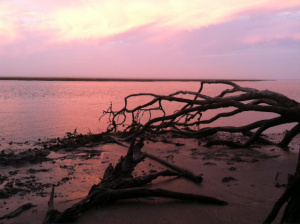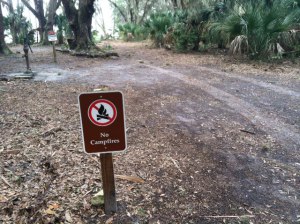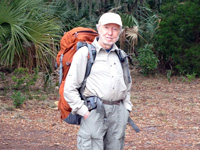Hovercraft Ruling Deals a Major Blow to Land Conservation in Alaska
by Dana Johnson
In a major blow to conservation efforts in Alaska, including efforts to protect over 56 million acres of Wilderness in the state, the U.S. Supreme Court held that John Sturgeon, a moose hunter, can “rev up his hovercraft in search of moose” on the Nation River—a river that flows through the Yukon-Charley Rivers National Preserve in Alaska. The suit came after the Park Service told Sturgeon he could not use his hovercraft within the Yukon-Charley because Park Service regulations ban hovercraft within national preserves and parks. Sturgeon sued the Park Service, arguing that it had no authority to regulate activity on rivers in the preserve because the Alaska National Interest Lands Conservation Act (ANILCA) restricts Park Service authority to federally owned “public lands,” and the Nation River does not constitute federally owned public land under ANILCA. The Court agreed, noting, “If Sturgeon lived in any other State, his suit would not have a prayer of success” because the Park Service’s normal statutory authority would allow it to regulate both land and waters within parks and preserves, regardless of who owns the land and water. But, the Court found Alaska is “the exception, not the rule.”
ANILCA, signed into law in 1980, more than doubled the size of the National Park System and protected over 104 million acres of federally owned public land in the state, including over 56 million acres of new Wilderness. The Act designated such iconic Wildernesses as Denali, Gates of the Arctic, Glacier Bay, Katmai, Wrangell-Saint Elias, Izembek, Arctic Wildlife Refuge, Kenai, Misty Fjords, as well as many other Wildernesses administered by the National Park Service, the Forest Service, and the Fish and Wildlife Service. Unfortunately, the law also contains a number of bad provisions that affect federal agencies’ abilities to protect these areas from degradation.
The problem here comes with one provision within ANILCA stating, “Only those lands within the boundaries of any conservation system unit which are public lands (as such term is defined in this Act) shall be deemed to be included as a portion of such unit.” The Court noted that while the Park Service normally has broad authority to protect the land and water in parks, “add Section 103(c) [of ANILCA], and the equation changes.” Under this one provision, “[a]ll non-public lands (… including waters) [are] ‘deemed,’ abracadabra-style, outside Alaska’s system units,” and “[g]eographic inholdings thus become regulatory outholdings, impervious to the Service’s ordinary authority.” While the Park Service can still regulate “public lands flanking rivers,” and while it may still enforce regulations designed to protect its reserved water rights from diversion or depletion, it cannot apply park regulations to rivers in Alaska that fall outside of this narrow regulatory bubble.
Understandably, the Park Service argued that such a holding would significantly hamstring its ability to protect parks and preserves from degradation. Justices Sotomayor and Ginsburg seemed to agree. While they felt legally constrained to join the unanimous opinion, in a separate concurring opinion they highlighted the unintended consequences that can flow from compromise provisions in statutes. “Many of Alaska’s navigable rivers course directly through the heart of protected parks, monuments, and preserves. A decision that leaves the Service with no authority, or only highly constrained authority, over those rivers would undercut Congress’s clear expectations in enacting ANILCA and could have exceedingly damaging consequences.”
So, where does this leave things? The Court’s opinion states that the Park Service cannot apply park system rules and regulations to non-public lands and waters in Alaska. Presumably this would apply to other federal land management agencies. Justices Sotomayor and Ginsburg suggest that there may be avenues for the Park Service to regulate non-public areas when such regulation is necessary to protect parklands—it just can’t “apply normal park rules to nonpublic lands.” For example, while the Park Service can’t broadly prohibit hovercraft use on the Nation River under its general park ban, it might be able to prohibit hovercraft “in certain designated areas [on the River] to protect a particular sensitivity in a surrounding (public) park area, including some habitats on the banks of the Nation River.” Justices Sotomayor and Ginsburg also suggest that the opinion might have gone differently had the Nation River been designated a Wild and Scenic River, noting “the Service should retain full authority to regulate the Wild and Scenic Rivers as parklands.” But, the legal durability of those regulatory paths will be left for a different day, and the two Justices worry “that authority may be more circumscribed than the special needs of parks require… threaten[ing] the Service’s ability to fulfill its broader duty to protect all of the parklands through which the rivers flow.” To remedy harm caused by Section 103(c) of ANILCA, they note that “Congress can and should clarify the broad scope of the Service’s authority over Alaska’s navigable waters.”
Ultimately, this case is illustrative of the poison pill problem—compromise provisions made to get a conservation bill passed may ultimately weaken the law so substantially that its original intent is smothered by the weight of exception. In this case, one provision leaves navigable waters flowing through the heart of National Parks and Wildernesses in Alaska largely unregulatable by the federal agencies charged with protecting them. Buyer beware.
------------------
Dana Johnson is the staff attorney for Wilderness Watch, a national wilderness conservation organization headquartered in Missoula, MT, www.wildernessswatch.org.




